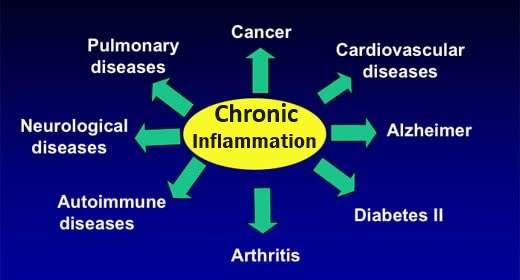Rheumatoid arthritis (RA) - Affects joints and is the most common inflammatory arthritis
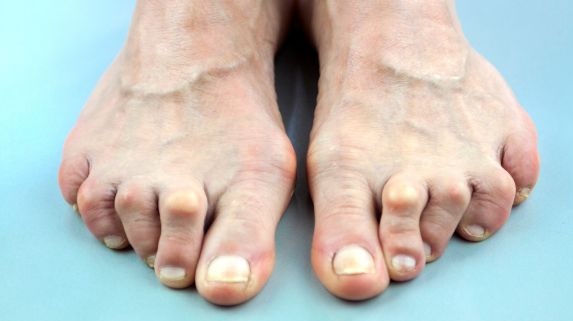
What is RA?
Characteristics of RA
- Joints become warm, swollen, painful and stiff. Usually worse early morning after waking and also following prolonged activity. RA can cause weakness, fatigue, loss of appetite, muscle pain, and weight loss.
- Usually affects hands, but can affect most joints. Eventually affecting multiple joints: small joints in wrists, fingers (usually middle joints and where fingers attach to hand), feet and cervical spine, but also larger shoulder and knee joints;
- RA can also occur systemically. E.g manifesting as spleen enlargement, blood vessel inflammation (vasculitis), heart / lung inflammation, muscle wasting, skin nodules, low white blood cell count.
- Tends to affect the same joints on both left and right sides of body (i.e. symmetrically)
- Affects 1 out of 100 people worldwide. Women 3x more than men, typical onset 40-60 years of age (although not a normal part of aging).
- At least 50% Increased risk of RA with repetitive movement. According to research involving self-reporting of 3680 RA patients and 5935 controls; this was especially evident in the construction industry with manual work above the shoulder level or below the knee level. Pingling Zeng et al
RA is an autoimmune disease. i.e. the body loses the ability to discriminate self proteins from non-self proteins, which ultimately results in the destruction of self tissues by the immune system. The synovial membrane (synovium) is a layer of cells that lines the joints and produces synovial fluid, a clear fluid that nourishes and lubricates the bone and cartilage in the joint. Cartilage is an elastic connective tissue covering the ends of bones to cushion and protect the bone from getting damaged during movement.
RA begins when infection-fighting white blood cells (WBCs) of the immune system (IS) accumulate in the synovial tissue – most likely in response to dietary or pathogenic antigens that have been deposited there (probably having “escaped” from a damaged/ “leaky” gut). Your body can confuse these “invaders” with your own tissue (in a process called molecular mimicry), and cause damage to your body tissue. Proinflammatory cytokines produced by the WBCs and IS acute phase proteins can cause inflammation (such proteins include interferons (IFNs), interleukins (ILs) IL-1, IL-6, tumor necrosis factor-α (TNF-α), and C-reactive protein (CRP)), and other immune cells attending the “party” can cause over-production of synovial fluid. Inflammation can spread to the entire joint and destroy cartilage.
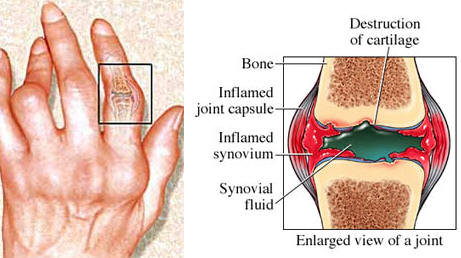
Synovial Fluid Lubricates and Nourishes Joint. Synovial fluid is a clear, thick, stringy lubricating fluid reducing friction between opposing cartilage surfaces. The synovial membrane (classified as connective tissue, not epithelium) seals the cavity of a synovial joint and secretes synovial fluid into this tough joint capsule.
Composed of:
- Hyaluronic acid (HA or hyaluronan). A polymer of disaccharides;
- Lubricin. Glycoprotein (~equal proportion to GAGs);
- Proteinases and collagenases. Enzymes that break down proteins and collagen resp.
RA can be diagnosed with C-reactive protein (CRP) is a marker for tissue damage / inflammation. CRP is a blood protein mainly produced in the liver, which increases dramatically during the acute phase inflammatory response. Even CRP>1mg/dL is high, but most inflammation results in CRP >10.

Rheumatoid arthritis symptoms
- Joint stiffness, swelling and pain. Often worse in the mporning or after inactivity
- Fatigue / weight loss
- Can affect other body areas E.g. skin, eyes, lings
- In Feet / Ankles – symptoms in the feet /ankles are usually in both feet / ankles simultaneously. RA can also trigger the growth of nodules (hard, round bumps under the skin) on the balls of the feet, toes or instep. Symptoms mainly occur in:
- The ball of the foot – where the long metatarsal bones in the foot meet the base of the toes
- Between the bones of the toes – i.e. the toe knuckles
- Back of the foot and ankle

Rheumatoid arthritis causes
Inflammation and autoimmune activity
In RA, several cytokines (chemical messengers that regulate inflammation) are involved in almost all aspects of joint inflammation and destruction – e.g. interleukin (IL)-1, IL-6, IL-8, IL-12, IL-17, tumor necrosis factor-α (TNF-α), interferon-γ (IFN-γ) and granulocyte-macrophage colony-stimulating factor (GM-CSFG), . In particular, TNF-α and IL-6 are considered to be pivotal cytokines in the development of RA.
What is initiating this uncontrolled inflammation?
- Bacteria or virus. Research suggests a connection to periodontal disease and smoking
- Repetitive over-use of a joint.
- A so-called “leaky gut” (Gut Permeability). It is an almost universal clinical observation that inflammation of the gut is frequently associated with inflammation of the joints and vice versa, but the nature of this relationship remains elusive. Factors involved are:
Poor gut microbiome A healthy gut needs a diverse population of good bacteria; lectin-tolerance is very much tied into microbiome health; Use of NSAIDs or other drugs will harm the microbiome.
Dietary lectins. A study of 800 people with autoimmune conditions, most with elevated TNF-α, went on diets that cut out high-lectin-content foods for 6 months, after which those that complied with the diet had normal TNF-α levels. Their diet avoided grains, sprouted grains, pseudo-grains, legumes, soy, peanuts, cashews, nightshade plants, melons, squashes, cow’s milk products (from cows producing casein A1 milk), and grain- and/or bean-fed animal meat. Gundry &Steven, 2014. Dietary substances, especially lectins, directly or indirectly (by increasing pathogenic bacteria populations, especially with unhealthy gut flora) inflame /damage villi lining the gut, allowing both lectins and pathogenic bacteria to enter the bloodstream. In circulation, the immune system (IS) recognizes them as antigens (foreign substances to be marked for destruction by antibodies). Evidence suggests that dietary lectins interact with IS white blood cells to facilitate the movement of both dietary and gut-derived pathogenic antigens into peripheral tissues. Immune system complexes formed by antigen and antibodies trigger the IS to release compounds to destroy them, and if deposited in joints of genetically susceptible individuals, will also damage the surrounding joint tissue. These pathogenic antigens may even interact directly with synovial tissues. Cordain et al, 2000
- Stress. Researchers found a strong connection between stress and the risk of developing RA. A meta-analysis of 16 small studies published in Arthritis Research & Therapy found that stress tends to make RA symptoms worse, that childhood trauma increases risk of rheumatic diseases (a 2009 study found that people who reported two or more traumatic childhood events – including physical, emotional, or sexual abuse — had twice the risk of rheumatic disease compared with those who reported no childhood trauma), and that those with PTSD have a higher risk of developing RA and other autoimmune disease. Hassett & Clauss, 2010. Another study found that stressful events often precede onset of RA.
- Increased collagenase activity. Collagenase is an enzyme that breaks down collagen. This would further cartilage damage in a joint
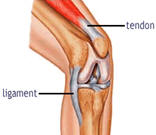
Some Differences between RA and OA | |
| Rheumatoid Arthritis (RA) | Osteoarthritis (OA) |
| Tends to affect middle joints of fingers and where fingers attach to hand | In the hand, OA most commonly affects the 1st and 2nd joints of the thumb (study published Apr.2011 in “Rheumatology), also joints at the ends of the fingers |
| Usually same joints are affected symmetrically on both sides of the body | Symmetry of affected joints on both sides of the body does NOT usually occur in OA |
| Joints often hurt for longer than 45 minutes after getting out of bed | Joints may be stiff in the morning, but typically feel better in about 20 minutes |

How to treat rheumatoid arthritis
Avoid dietary lectins PROLAMIN and AGGLUTININ
Lectins PROLAMIN and AGGLUTININ are inflammation-causing anti-nutrients in our diet.
Prolamin includes gliadin (the actual culprit in gluten) found in such as wheat, barley, and rye. Other prolamins are zein in corn, hordein in rye, seculin in barley, and avenin in oats (in small amounts, provided they have not been cross-contaminated with other high lectin grains). In the Western diet, Prolamins and agglutinin are primarily eaten in IMPROPERLY PREPARED:
- Grains e.g. wheat, brown rice, rye, barley, corn
- Legumes / beans – especially peanuts, soybeans,
- Cashews, tomatoes (remove seeds/skins), potatoes, peppers, eggplant

Regenerate collagen to rebuild joint cartilage
Collagen is the main component of the cartilage providing cushioning between your bones – the collagen molecule comprises 3 tightly wound chains of 3 repeating amino acids – glycine, lysine and proline.
Collagen production requires that you ensure 4 MAIN ingredients in your diet – which may be lacking:
- Proline – key component of collagen; body synthesizes small amounts of this non-essential amino acid, but it may not be enough to balance collagen destruction by enzymes.
- Vitamin C (Ascorbic Acid) – Hydroxyproline results from oxygen reacting with proline, a reaction dependent on vitamin C.
- Copper (2-4 mg/day) – a component of the enzyme lysyl oxidase required for synthesis of collagen and elastin. Also, an integral part of SOD, the major endogenous antioxidant enzyme. Excellent sources: calf’s liver, crimini mushrooms, turnip greens, molasses; Very good sources: chard, spinach, sesame seeds, mustard greens, kale, summer squash, asparagus, eggplant, cashews.
- Lysine (essential amino-acid) – sufficient lysine blocks the anchor sites in connective tissue for enzymes which would otherwise digest collagen
Rath / Pauling Therapy provides proline, lysine and vitamin C
- Zinc deficiency reduces collagen in the body and is common in high-phytate diets. You can begin with higher doses (50mg) for just a few days to take care of a deficiency, but only ~10 mg / day is sufficient as a maintenance dose – can be obtained in ~1/4 Cup of raw pumpkin seeds. Too high a dose depletes magnesium and copper.
GAGs (glycosaminoglycans)
GAGs are a “gel-like”, water-absorbing, filler substance between collagen. If you think of a net cast in the sea, the net (collagen) will collapse without the sea (GAGs).
Chondroitin – the most prevalent GAG in connective tissue. Chondroitin works as a therapy if directly injected into the affected joint (There is much controversy as to whether a high molecular mass supplement, such as the commonly used Chondroitin Sulfate, can be absorbed by the intestines. Some saying that its supporting studies are really paid ads in medical journals. Interestingly, their beneficial actions, if any, may be in supplying needed sulfur, which protects collagen from damage.
Benefits of chondroitin include:
- Attracts water to cartilage, improving its ability to absorb shocks and impacts from movement.
- Inhibits enzymes in synovial fluid that cause cartilage destruction.
- Stimulates production of chemicals which improve synovial fluid viscosity
Glucosamine (500mg/day). Promotes GAG production and is a component of hyaluronic acid.
Comfrey – Author’s #1 TREATMENT for Building Collagen |
|---|
This herb has been used for centuries to very successfully build collagen in the body.
|
Other treatments for RA
- Antioxidant vitamins – to control further free radical damage. Tart cherry juice is rich in polyphenols.
- Quit smoking – which boosts risk of RA and may speed up disease or cause more joint damage.
- Take care of gums – there is an association between RA and periodontal disease.
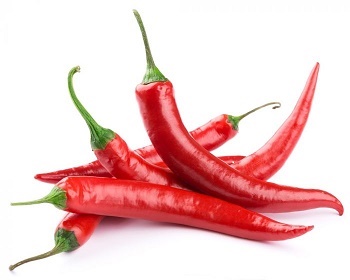
- Transdermal cayenne pepper cream / lotion / oil or 0.025 – 0.075% capsaicin gel or cream (readily available). Cayenne’s active ingredient capsaicin relieves pain by numbing sensory nerves (gradually reduces substance P, a chemical necessary for nerves to send pain signals to the brain) and also increases circulation to aid healing of joints and/or muscles.
- Apply up to 4 times daily to affected area. Treatment can take 3 to 7 days to relieve pain and inflammation.
- DIY cayenne pepper recipe: Mix half a teaspoon cayenne pepper into 1 cup carrier oil (E.g. olive oil or comfrey oil) or lotion (containing natural ingredients).
- Pulsed Electromagnetic Field (PEMF) therapy
- Probiotics
- DMSO. For pain / Anti-inflammatory
- Transdermal Magnesium Chloride
- Low Dose Naltrexone (LDN). A successful off-label / very low dose use of a medical drug
- Rath-Pauling Therapy. A high dose vitamin C therapy to strengthen the body’s collagen
- MSM (1 to 6 1000 mg capsules / day). Contains sulfur, which protects from damage to collagen by cross-linking, and provides flexibility and permeability to cell membranes.
- Evening primrose / Borage oil. Rich in anti-inflammatory omega-6 DGLA fatty acids, competitive inhibitors to omega-6 arachidonic acid (AA) conversion to inflammatory leukotrienes. See eicosanoids. Belch JJ, 2000
References
Belch JJ, Hill A. Evening primrose oil and borage oil in rheumatologic conditions. Am J Clin Nutr. 2000 Jan;71(1 Suppl):352S-6S. doi: 10.1093/ajcn/71.1.352s. PMID: 10617996.
Hassett, A. L., & Clauw, D. J. (2010). The role of stress i n rheumatic diseases. Arthritis research & therapy, 12(3), 123. doi:10.1186/ar3024 LInk












